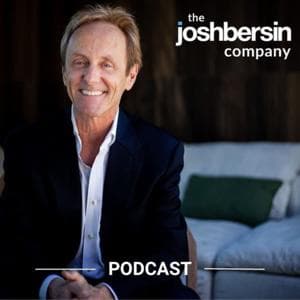Just two years ago, AI was a shiny new object in L&D, with most professionals dabbling in small pilots and content creation experiments. The latest findings reveal an inflection point: the majority of L&D teams are now actively using AI, not merely testing it.
This week, on the podcast are Donald H. Taylor and Eglė Vinauskaitė, the minds behind a groundbreaking new report, "AI & Learning 2025: Race for Impact." We’re exploring the rapid changes AI is bringing to Learning and Development (L&D), from early experimentation to widespread implementation, and what it means for the future of work.
In this conversation, you’ll hear about the three distinct futures for L&D departments, how AI is moving beyond simple content creation into qualitative analytics and adaptive learning, and why team culture and leadership are crucial for success. We also dig into some big philosophical questions: How do we keep humans at the center of tech-driven workplaces? And how will AI reshape the very definition of value in L&D?
This episode is packed with insights, data, and stories from organizations at the forefront of change. So, get ready to rethink how learning happens and how impactful workplace transformation can be.
You will want to hear this episode if you are interested in...
- [00:00] How AI is transforming Learning and Development.
- [05:40] Transition from experimentation to mainstream implementation of AI in L&D.
- [13:31] Debunking the maturity model.
- [16:03] AI integration culture in organizations.
- [25:07] AI's impact on L&D values.
- [38:54] Necessity for L&D to demonstrate clear impact and unique value beyond content.
- [47:36] Leadership Beyond the L&D silo.
- [52:25] Introduction of the “transformation triangle”: three potential strategic futures.
The Rapid Evolution of AI in L&D
AI usage still predominantly supports content creation and design, but there’s an intriguing rise in more sophisticated applications, especially data analysis, dynamic feedback, and even AI-driven coaching. For L&D leaders, the big question is no longer “should we use AI?” but “how can we use it to unlock deeper value for our organizations?”
What Sets Successful L&D Teams Apart?
A critical insight from the report is the role of mindset and organizational culture in successful AI adoption. Teams thriving with AI aren’t necessarily bigger or better-resourced; they are “open” teams, led by individuals who embrace risk, imperfect information, and proactive change. These leaders are comfortable experimenting without knowing all the answers, an essential trait for the current landscape.
True transformation requires more than tech skills; it demands business acumen, a robust understanding of performance, and an ability to integrate learning with business strategy. L&D teams must move from being passive order-takers to strategic partners, actively shaping how people develop and perform.
AI: Threat or Opportunity for Traditional L&D Roles?
For some, the rise of AI in learning is unnerving. Tasks once considered core, like instructional design or content creation, can increasingly be automated, often cheaper and faster than before. Taylor cautions that unless L&D professionals shift their value proposition from content production to driving true impact, their roles risk being diminished or redefined.
But there is an opportunity for L&D to expand its influence. Rather than being relegated to the background, teams can now focus on performance support, skills stewardship, and facilitating human growth, areas where strategic thinking and deep expertise are critical and cannot be automated away.
Three Futures for L&D: Skills Authority, Enablement Partner, Adaptation Engine
Perhaps the most provocative segment of the episode introduced three possible “futures” for L&D roles in the AI era:
Skills Authority: L&D becomes the custodian of skills, owning skill taxonomies, plumbing, and strategic workforce development. This future demands advanced expertise in identifying, building, and tracking capabilities crucial to business success.
Enablement Partner: Here, L&D empowers employees across the organization to create their own learning solutions. The team shifts from direct content delivery to building infrastructure, processes, and trust, letting expertise flourish where it’s needed most.
Adaptation Engine: The most radical scenario, where L&D is absorbed into cross-functional teams focused on rapid business adaptation. Learning professionals blend with design, tech, and operations to solve holistic problems, making learning indistinguishable from broader performance improvement.
While AI will eventually become as invisible as electricity, the human element in learning, facilitation, creativity, and stewardship remains paramount. The priority for leaders now is to harness AI thoughtfully, ensuring it serves genuine learning and performance goals rather than just delivering faster horses.
Resources & People Mentioned
- AI in L&D: The Race For Impact
- AI in L&D (4 Reports)
Connect with Donald H. Taylor and Eglė Vinauskaitė
- Egle Vinauskaite on LinkedIn
- Donald H Taylor on LinkedIn
Connect With Red Thread Research
- Website: Red Thread Research
- On LinkedIn
- On Facebook
- On Twitter
Subscribe to WORKPLACE STORIES



































